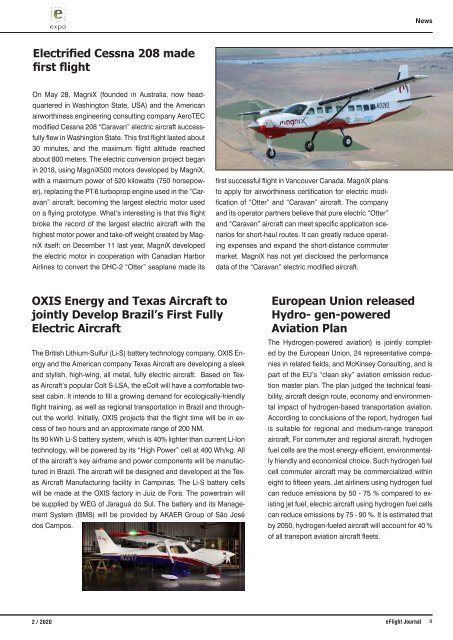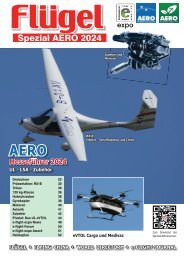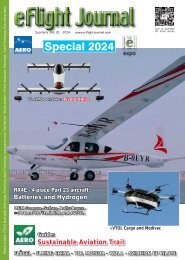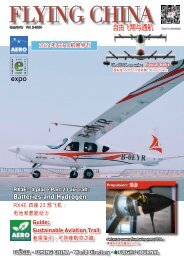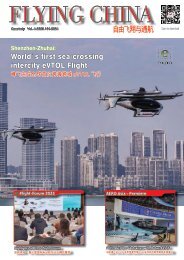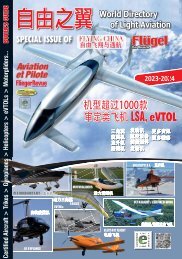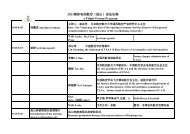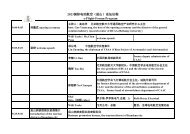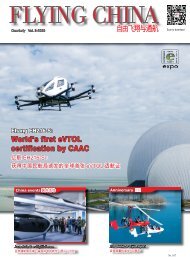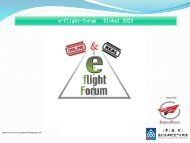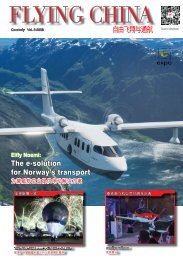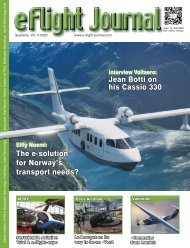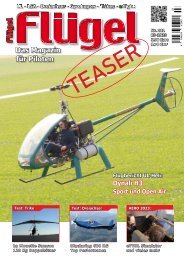eFlight Journal 02-2020
E-Flight Journal 2-2020
E-Flight Journal 2-2020
- No tags were found...
Create successful ePaper yourself
Turn your PDF publications into a flip-book with our unique Google optimized e-Paper software.
News<br />
Electrified Cessna 208 made<br />
first flight<br />
On May 28, MagniX (founded in Australia, now headquartered<br />
in Washington State, USA) and the American<br />
airworthiness engineering consulting company AeroTEC<br />
modified Cessna 208 “Caravan” electric aircraft successfully<br />
flew in Washington State. This first flight lasted about<br />
30 minutes, and the maximum flight altitude reached<br />
about 800 meters. The electric conversion project began<br />
in 2018, using MagniX500 motors developed by MagniX,<br />
with a maximum power of 520 kilowatts (750 horsepower),<br />
replacing the PT-6 turboprop engine used in the “Caravan”<br />
aircraft, becoming the largest electric motor used<br />
on a flying prototype. What’s interesting is that this flight<br />
broke the record of the largest electric aircraft with the<br />
highest motor power and take-off weight created by MagniX<br />
itself: on December 11 last year, MagniX developed<br />
the electric motor in cooperation with Canadian Harbor<br />
Airlines to convert the DHC-2 “Otter” seaplane made its<br />
first successful flight in Vancouver Canada. MagniX plans<br />
to apply for airworthiness certification for electric modification<br />
of “Otter” and “Caravan” aircraft. The company<br />
and its operator partners believe that pure electric “Otter”<br />
and “Caravan” aircraft can meet specific application scenarios<br />
for short-haul routes. It can greatly reduce operating<br />
expenses and expand the short-distance commuter<br />
market. MagniX has not yet disclosed the performance<br />
data of the “Caravan” electric modified aircraft.<br />
OXIS Energy and Texas Aircraft to<br />
jointly Develop Brazil’s First Fully<br />
Electric Aircraft<br />
The British Lithium-Sulfur (Li-S) battery technology company, OXIS Energy<br />
and the American company Texas Aircraft are developing a sleek<br />
and stylish, high-wing, all metal, fully electric aircraft. Based on Texas<br />
Aircraft’s popular Colt S-LSA, the eColt will have a comfortable twoseat<br />
cabin. It intends to fill a growing demand for ecologically-friendly<br />
flight training, as well as regional transportation in Brazil and throughout<br />
the world. Initially, OXIS projects that the flight time will be in excess<br />
of two hours and an approximate range of 200 NM.<br />
Its 90 kWh Li-S battery system, which is 40% lighter than current Li-Ion<br />
technology, will be powered by its “High Power” cell at 400 Wh/kg. All<br />
of the aircraft’s key airframe and power components will be manufactured<br />
in Brazil. The aircraft will be designed and developed at the Texas<br />
Aircraft Manufacturing facility in Campinas. The Li-S battery cells<br />
will be made at the OXIS factory in Juiz de Fora. The powertrain will<br />
be supplied by WEG of Jaraguá do Sul. The battery and its Management<br />
System (BMS) will be provided by AKAER Group of São José<br />
dos Campos.<br />
European Union released<br />
Hydro- gen-powered<br />
Aviation Plan<br />
The Hydrogen-powered aviation) is jointly completed<br />
by the European Union, 24 representative companies<br />
in related fields, and McKinsey Consulting, and is<br />
part of the EU’s “clean sky” aviation emission reduction<br />
master plan. The plan judged the technical feasibility,<br />
aircraft design route, economy and environmental<br />
impact of hydrogen-based transportation aviation.<br />
According to conclusions of the report, hydrogen fuel<br />
is suitable for regional and medium-range transport<br />
aircraft. For commuter and regional aircraft, hydrogen<br />
fuel cells are the most energy-efficient, environmentally<br />
friendly and economical choice. Such hydrogen fuel<br />
cell commuter aircraft may be commercialized within<br />
eight to fifteen years. Jet airliners using hydrogen fuel<br />
can reduce emissions by 50 - 75 % compared to existing<br />
jet fuel, electric aircraft using hydrogen fuel cells<br />
can reduce emissions by 75 - 90 %. It is estimated that<br />
by 2050, hydrogen-fueled aircraft will account for 40 %<br />
of all transport aviation aircraft fleets.<br />
2 / 2<strong>02</strong>0<br />
e Flight <strong>Journal</strong><br />
9


